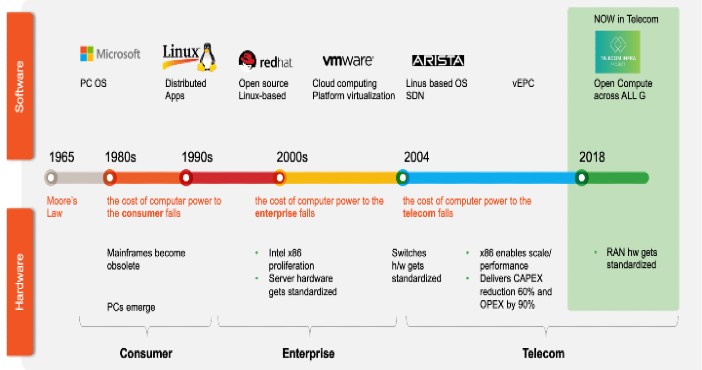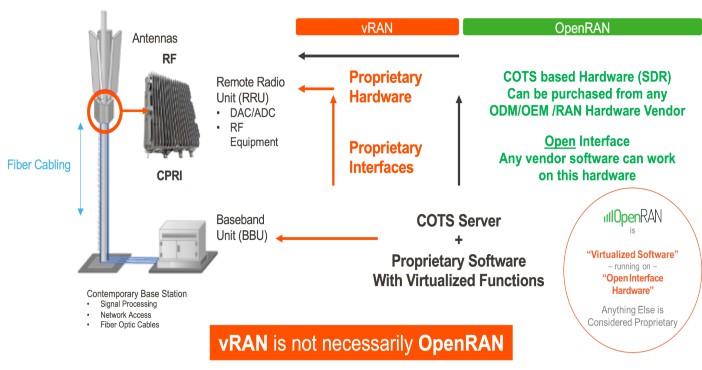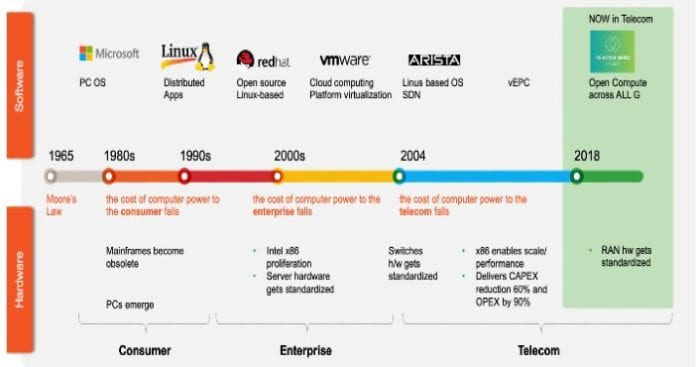History
The entire telecom industry is going through a dramatic change that can be only compared to the change that data centers went through in the 2000s, all driven by Moore’s Law. This is driving the need to move from costly, proprietary RAN solutions to COTS and open, software-based ones, and to create a broader vendor supply chain.
Evolution of HW/SW Disaggregation

Image courtesy of Parallel Wireless. The main takeaway here: Software is only as good as underlying hardware. Once there were COTS servers available to disaggregate the RAN, the Open RAN movement got its wind.
Why?
Most of the CAPEX required to build a wireless network is related to the RAN segment, reaching as high as 80% of the total network cost. Any reduction in the RAN equipment cost will significantly help the bottom line of wireless operators as they struggle to cope with the challenges of ever-increasing mobile traffic and flat revenues. Forecasts show 5G deployment costs falling 30% between now and 2022 if a network is built in the traditional way, but those deployment costs could drop by 50% if an open architecture is used. MNOs are also realizing that opening up the RAN for only 5G will not reduce the overall network TCO. The operators believe that modernizing their legacy networks, in addition to deploying 5G, will reduce their overall network OPEX as they will have one unified network to run and will be able to make time and cost-saving remote upgrades to the overall site.
The concept of Open RAN goes beyond just standards interoperability. In theory, a RAN built by any of the legacy vendors is supposed to be interoperable with any device, any core, and any transmission network due to its conformance with 3GPP standards. Right? Not so much, actually. Though the interfaces are “supposed” to be open, in traditional RAN deployments, the software and interfaces remain either proprietary or optimized by the individual vendor and are often tied to the underlying hardware by the SAME vendor. Meaning operators cannot put vendor B’s software on a BBU from vendor A. Any software upgrades are tied into the installed base, and if an operator wants to do a swap, they need to rip out all of it: from the radio to the BBU hosting the software. Wouldn’t it be much easier to 1. keep the radio on the tower, installed, so no one has to climb and replace it, and 2. keep the BBU at the bottom of tower, and 3. simply upgrade the software remotely without going to a site?
The main takeaway: Following data center = software-driven deployment model will reduce deployment cost and help avoid vendor lock-in.
What?
About 10 years ago, virtualization of the RAN started with the C-RAN (cloud RAN or centralized RAN) initiative from IBM, Intel and China Mobile. C-RAN resulted in a deployment model where a baseband unit that was doing digital processing could be located in a data center and not on the site itself – under the radio or RRH (remote radio head unit) where the radio processing was happening – and was instead connected to the baseband unit via a dedicated high-bandwidth connection. The C-RAN required a new fronthaul interface, and various industry standards such as the Common Public Radio Interface (CPRI) and the Next Generation Fronthaul Interface (NGFI) evolved to enable these new interfaces between the radios and baseband. C-RAN wasn’t necessarily open as we understand it today, but it did begin the movement toward disaggregating the RAN
Next came Virtual RAN, or vRAN. Does Open RAN equal Virtual RAN? Not exactly. Let us explain. With vRAN, the proprietary hardware remains as it is, but the BBU gets replaced by a COTS server rather than proprietary hardware. The software that runs on the BBU is virtualized to run on any COTS server. The proprietary interfaces remain as they are. Here’s a picture that illustrates how we see it.
Virtualized RAN (vRAN) versus OpenRAN

Image courtesy of Parallel Wireless.
The point to emphasize here is that vRAN is not Open RAN as it is not completely open; it still contains proprietary interfaces and purpose-built hardware. Open RAN is, instead, a movement to define and build 2G, 3G, 4G and 5G RAN solutions based on a general-purpose, vendor-neutral hardware and software-defined technology. Open RAN Is the disaggregation of hardware and software: the RRU / RRH hardware becomes a GPP-based or COTS hardware that can be purchased from any ODM, OEM or RAN hardware vendor. The BBU is the same as in the case of vRAN: COTS server + vendor’s proprietary software with virtualized functions.
The main thing with Open RAN is that the interface between the BBU and RRU / RRH is an open interface, so, any vendor’s software can work on any open RRU / RRH. With Open RAN and the “virtualization” it brings, operators should be able to run software-based network functions on standard servers. More open interfaces enable them to use one supplier’s radios with another’s processors — something not currently possible with traditional solutions.
The OpenRAN vision is that the RAN is open within all aspects, with the interfaces and operating software separating the RAN control plane from the user plane, building a modular base station software stack that operates on commercial-off-the-shelf (COTS) hardware, with open north- and south-bound interfaces. This software enabled Open RAN network architecture enables a “white box” RAN hardware – meaning that baseband units, radio units and remote radio heads can be assembled from any vendor and managed by Open RAN software to form a truly interoperable and open network. This way, the underlying hardware layer (radios and servers) stay on site; the only thing that gets replaced is the software as shown in the graphic below.
Example scenario: OpenRAN deployment model

Image courtesy of Parallel Wireless. The main takeaway here is that a mobile operator can virtualize and disaggregate their RAN, but unless the interfaces between the components are open, the RAN is not truly open.
How?
In the next blog, we will talk in detail about RU, CU, DU and all that “acronym soup” and what it means. Right now, here are some basics. 3GPP considered the split concept (DU and CU) from the beginning for 5G. In a 5G cloud RAN architecture, the BBU functionality is split into two functional units: a distributed unit (DU), responsible for real time L1 and L2 scheduling functions, and a centralized unit (CU) responsible for non-real time, higher L2 and L3. In a centralized 5G cloud RAN, the DU physical layer and software layer are hosted in an Edge cloud datacenter or central office, and the CU physical layer and software can be collocated with the DU or hosted in a regional cloud data center. While CUs will maintain BBU-like functionalities, DUs will be more than RRH in terms of processing capacities. And this is where the Open RAN concept comes in: from COTS-based servers for DU and CU software to RU from any vendor. Open RAN is the key to next-generation mobile network infrastructure and as a result of vendor interoperability, it offers:
- Ability to use non-ideal fronthaul (i.e. Ethernet), overcoming the traditional constraints of CPRI over fiber: Legacy RAN platforms have been based on proprietary hardware and rely on long and costly life cycles in development, deployment, and operation. This created vendor lock-in and the inability to keep pace with technology and demographic changes. With each generation of radio interface change, these radios are typically replaced with newer versions at a significant investment and inconvenience to mobile operators, as they must crew to each site to rip and replace.
- Ability to select any COTS-based BBU (Remember the original dilemma when an operator could not put vendor B’s software on a BBU from vendor A? Not an issue any more.) and pool them as necessary for ALL G deployments: a strategic software differentiation by enabling the Open-RAN based Remote Radio Units (RRUs) to interwork with the COTS-based Virtualized Baseband Unit (vBBU), preventing vendor lock-in.
Open RAN is about horizontal openness – with open interfaces enabling functions of the RAN to connect with other functions, from a radio unit (RU) to a baseband (DU-CU), to the controller to the NMS/orchestrator.
And though the functional split concept was introduced for 5G, to get full interoperability and cost benefit, it must be applied to RAN for 2G 3G 4G as well.
The main takeaway: When RAN is opened up horizontally, it could bring in a new range of low-cost radio players, and it gives mobile operators a choice to optimize deployment options for specific performance requirements at much better cost.
When?
The Telecom Infra Project (TIP) was set up in early 2016 as MNOs were frustrated with a lack of innovation in a highly concentrated/closed ecosystem and high costs in the telecom equipment sector. The Open RAN TIP group has brought together operators, traditional equipment vendors and startups that are using open source technologies and open approaches.
In June 2018, Vodafone and Telefónica announced a joint RFI to evaluate RAN technologies that are software-based and that run on top of commoditized hardware.
At TIP Summit in October 2018, Telefónica and Vodafone announced the vendors they are using in their Open RAN pilot deployments. Telefónica and Vodafone sought an Open RAN platform that could provide 2G, 3G, and 4G in addition to 5G. Both operators were aligned on the need to scale these solutions in their rural footprint first as one of the levers for success. The effort in TIP was done to push the sustainable growth of the Open RAN technology driving the industry toward a new generation of open solutions.
As part of the Telecom Infra Project (TIP), Facebook is working closely with telecom service providers and operators to accelerate innovation, new technology, and business approaches to help the industry build the networks of the future. Through this program, Facebook is working with operators in areas that have not been covered with any kind of communication services in various geographies, such as Latin America and some parts of Europe. The cost attractions of Open RAN enabled by interoperability could prove important in such diversified markets from high-income to low-income markets.
Vodafone, the leading innovator in Open RAN, recently noted “the global supply of telecom network equipment has become concentrated in a small handful of companies over the past few years. More choice of suppliers will safeguard the delivery of services to all mobile customers, increase flexibility and innovation and, crucially, can help address some of the cost challenges that are holding back the delivery of internet services to rural communities and remote places across the world.”
Vodafone added the move will improve “supply chain resilience,” introducing “a wave of new 2G, 3G, 4G and 5G technology vendors, in addition to the existing market leaders.”
The O-RAN Alliance was formed after the merger of the C-RAN alliance and XRAN. Today, it has more than 160 mobile operators, vendors, and research & academic institutions operating in the Radio Access Network industry. The O-RAN Alliance publishes new RAN specifications, releases open software for the RAN, and supports its members in integration and testing of their implementations. But as mentioned before, for Open RAN to be open, the interfaces need to be open. The greatest example of it is Nokia in the Rakuten deployment, when they opened up their radios to another vendor’s software.
TIP is not writing specs like O-RAN Alliance, but rather TIP is promoting, educating and deploying OpenRAN globally, starting in LATAM in 2016, then with Vodafone in Asia, Europe and DRC.
Global MNOs are realizing the economic benefits of open architecture. They are setting up teams and focusing on innovation and engagements in Open RAN architecture. While earlier they used to buy hardware and software together from a particular supplier, they are now splitting the orders for hardware and software. This will result in significant CAPEX and OPEX realizations, competency and faster deployments.
The main takeaway: contrary to the information being published by legacy RAN vendors, Open RAN is real; Open RAN has been deployed in commercial networks today; the Open RAN community is thriving; the cost savings are being realized; and operational performance requirements and KPIs are being met.
In our next installment, we will look at what is RU, CU, DU and why they matter.

